Optimizing Project Communications
Having decided who needs to receive what information and when the next consideration is what is the best method to use for this communication. Later sections of the project communications management plan explain who is going to perform the update and how this will be accomplished.
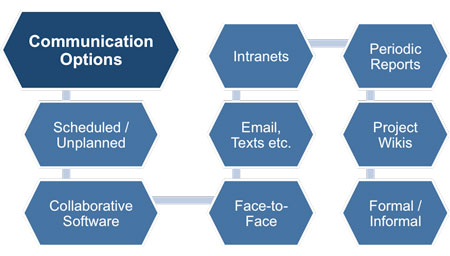 |
There are many ways to communicate, including unscheduled and informal face-to-face meetings, periodic reports, project wikis, collaborative software, video-conferencing and email. When deciding on the appropriate technology for each type of communication the project manager should ask himself or herself...
How time-sensitive is the information?
Does communication need to be interactive?
Should the information be 'pushed' or 'pulled'?
What technology is actually available?
What technologies are the stakeholders familiar with?
How much expenditure can be justified?
Does the environment 'force' certain decisions?
Project managers often want produce special reports at pre-defined milestones that will be reported on outside of their specific communications schedule that has been created. For example, halfway through the project they might deem it appropriate to send a special update to all interested stakeholders.
If information is time-sensitive or frequently updated then you will need to make a decision about whether it needs to be available immediately, or would regularly issued reports suffice?
Where the information to be sent may invite discussion for example then he or she may feel it is best done interactively in a meeting, phone call, or a video-conference. The alternative is usually a seemingly endless round of emails that can be both time consuming and frustrating particularly when there are more than two parties involved.
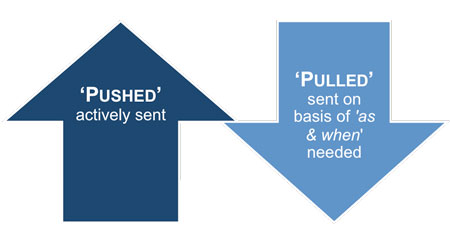 |
When communicating you need to consider if the information should be:
'Pushed' - actively sent (via email for example) or
'Pulled' - sent in a way that lets the interested access it as and when needed (for example, post it on a blog or project wiki)
You also need to take into account what technology is available and to know if the relevant stakeholder(s) have access to it. There may be differences in the types of technology that are used internally by the project team and that used by other stakeholders. This extends to the compatibility of the experience and expertise of the stakeholders compared to the project team.
In some instances the project manager would need to decide if training is needed and then assess if there is sufficient time and money to conduct it. This will depend on the project complexity and duration. Spending money on improving the communications infrastructure may well be justified in the case of a long and complex project, particularly if it can be used on subsequent projects.
Finally, the nature of the project environment may 'force' certain decisions. It may operate on a face-to-face basis or in a virtual environment. This will have a significant influence on the communications technology that should be chosen. The project manager may find that they have to adopt more comprehensive technology in a virtual project, for example a teleconferencing system.
People often communicate with little or no thought for the existing knowledge of their audience. For example, they use jargon that the audience/receiver is not familiar with or make assumptions about the level of expertise they have. Encoding the message for the audience/receiver could be as simple as defining the letters of an acronym and providing a few words of explanation. This is illustrated below.
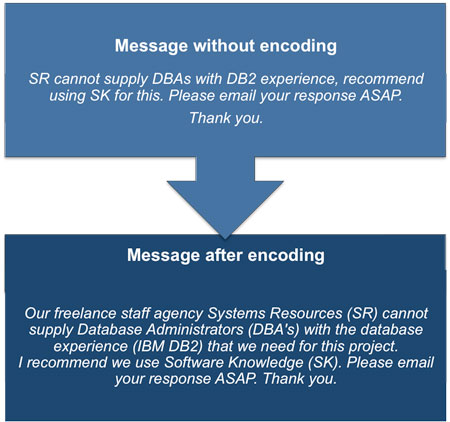 |
This example clearly shows that the original message is incomprehensible to anyone without knowledge of the language, roles and practices of a particular IT department. In it's original form, it may only be understood by a handful of people. However, once it has been encoded any person involved in this project would be able to understand it.
The next stage of this basic communication model is to send the encoded message to the recipient. This person then has the job of decoding the message in a way they can relate to. It is at this stage that messages may be changed, filtered, misinterpreted or edited so that it meets the receiver's own preconceived framework.
From this example it is easy to see that the non-encoded message is open to great number of interpretations depending on the knowledge and experience of the receiver. But once the message is encoded its content and meaning are straightforward giving a clear explanation of the situation the project needs resolving.
This basic communication model also contains the concepts of:
Noise is anything that interferes with the transmission and understanding of the message (for example, unfamiliar technology or lack of background information).
Decoding, that is the work required to translate the message back into meaningful thoughts or ideas.
The reason for encoding is simply to eliminate noise from the message and to make the process of decoding it as straightforward as possible for the receiver. It also illustrates that communication cannot be considered complete until the receiver has fed their response back to the sender.
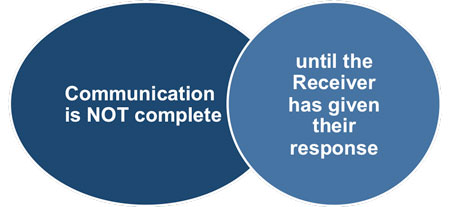 |
Note that the encoded message in the example makes this clear by specifically asking for a response. The original sender can then decide whether the message has been understood in the way that they expected. If it has not, they can do something about it before it becomes a problem.
These methods can be broadly classified into 'interactive', 'push and 'pull', all of which were alluded to in the discussion of communication technology above.
Interactive communication includes meetings, phone calls and videoconferencing. This is the most efficient way reach a consensus between different parties.
Push communication includes emails, memos, reports, voice mails and press releases sent to stakeholders who need to know the information. This ensures that the information is distributed but does not certify that it actually reached or was understood by the intended audience.
Pull communication includes blogs, wikis and other software that supports collaborative working. It can be used for things like technical standards or support where people need to be able to access sub-sets of the information at their own discretion.
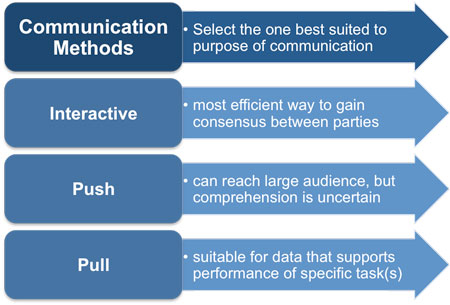 |
The project manager decides, based on communication requirements, what, how, and when communication methods are to be used in the project. This process requires discussion and dialogue with the project team to determine the most appropriate way to update and communicate project information, and to respond to requests from various stakeholders for that information.
Almost all of the processes that form part of project schedule managementwill involve meetings between the project manager, the team and other stakeholders in order to make decisions about the activity definitions and associated estimates. How well these meetings are conducted will have a major impact on how smoothly the project runs.
If you want to know more about how to improve your project meetings, then visit our online library and download free any of the eBooks, checklists and templates in the 'Meeting Skills'. These free eBooks cover all aspects of meetings including how to set an agenda that will ensure that the meeting achieves it's aims and how to chair a meeting so that it is as productive as possible.
You may also be interested in:
Managing a Project Team | Developing the Project HR Plan | Building an Effective Project Team | Developing the Project Team | Dealing with Conflict in the Project Team | Planning Project Communications | Optimizing Project Communications | Managing Project Communications | Identifying Project Stakeholders | Keeping Project Stakeholders Informed.
|
|


